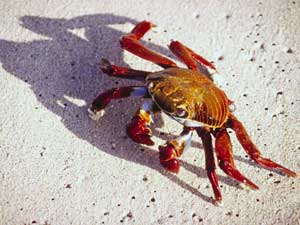In recent days, the people of Europe have been increasingly worried about the “brazen and escalating invasion” by giant sea crabs. These crabs can weigh up to 8 kg and have claws reaching… 1.5 m long, boldly crawling along the beaches of Norway.
 |
|
(Photo: screensavers) |
European ecologists are currently puzzled, as they have not yet determined why these “uninvited guests” have chosen to leave their beloved homeland in the far north of the Russian Far East to migrate to the distant Scandinavian Peninsula in Northern Europe.
To reach the waters of Norway, these sea crabs have had to swim and navigate a perilous journey along the icy shores of vast Russia, spanning thousands of nautical miles. Some imaginative ecologists speculate: “This could very well be a plot to invade Europe with giant sea crabs orchestrated by the Russians?!”
The giant sea crab species breeds and grows rapidly. Forty years ago, in the waters of Kamchatka, locals would rarely find a pair of large crabs, but the situation now is vastly different. It is estimated that there are currently about… 1 million of these crabs in Norwegian waters, and in the coming days, the number of these hefty crabs is expected to increase at a staggering rate!
According to the latest reports from scientists, some of these sea crabs now weigh as much as… 12 kg and have claws up to… 2 m long. The Oslo Marine Research Institute has sounded the alarm about the “sudden invasion of this extraordinary crustacean” in the waters of the Nordic country. Meanwhile, the Norwegian government has allocated 600,000 Euros for research efforts to find measures to limit and eliminate the unwanted migration of giant sea crabs into its continental shelf and territorial waters.
It seems that these giant arthropods have been “planning to invade Europe” for a long time. Recall that in the early 20th century, only a few giant crabs of a different species accompanied Chinese merchant ships to the mouth of the River Thames. Now, the relatives of these crabs have been proliferating in various locations across the North Sea.
With the mass migration of the Kamchatka giant crab, it is likely that two great “armies of crabs” will unite in the Arctic Ocean, something that European scientists are deeply concerned about and hope to avoid. If this occurs, a vast area of the old continent’s waters could be severely polluted and devastated by the overwhelming number of these large and voracious crabs!


















































